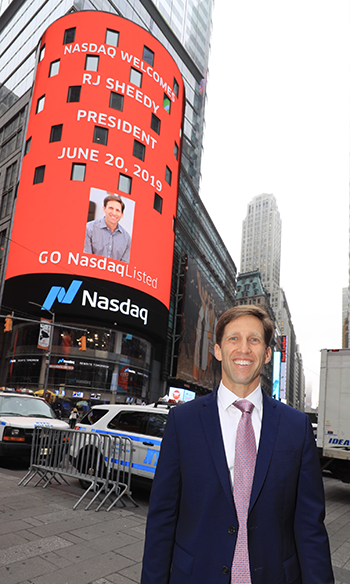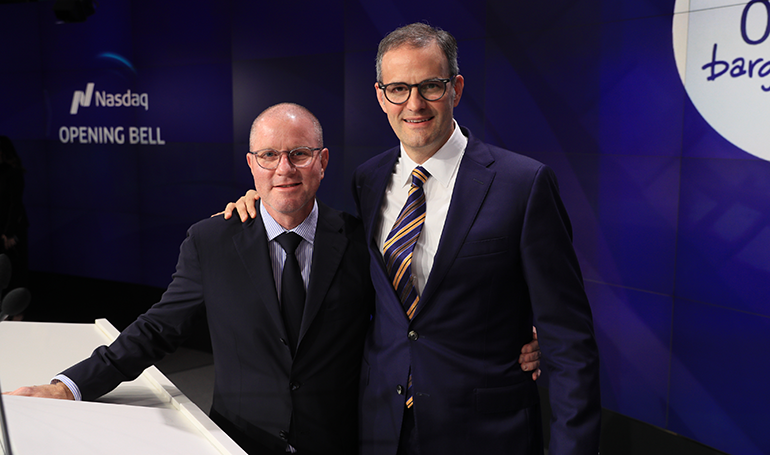Grocery Outlet Bargain Market today began trading on the public market, with shares launching well above the company’s expected pricing for its initial public offering.
Made as Grocery Outlet Holding Corp., the IPO opened on the Nasdaq Global Select Market Thursday at $31 per share of common stock. The price jump followed an upgrade to $22 last evening from the initial price target of $15 to $17 when the IPO was announced earlier this year.
The extreme-value grocery chain said the public offering is for 17,187,500 shares. Based on the $16 midpoint of the initial price range, the offering is expected to generate net proceeds of $249.8 million, which the company said it plans to use to pay down debt. Another 2,578,125 shares have been made available for purchase to the IPO’s underwriters under a 30-day option.
Emeryville, Calif.-based Grocery Outlet said the offering is slated to close on June 24. Now trading under the symbol “GO,” the company expects to have 85,703,639 shares of common stock outstanding following the IPO. An investment fund affiliated with Hellman & Friedman LLC, the retailer’s current principal owner, will hold majority voting power for all outstanding common shares after the IPO is completed.
“The fun part of this has been telling the story of the things we love about the business and the interest and positive reception we’ve received from the investor community,” Grocery Outlet President R.J. Sheedy said in an interview Thursday after the IPO.
“We’ve been talking about the long history of growth in this company over the past 73 years; the value that we provide to our customers — the best value in food in the country; the brands that we offer; the quality of consumables and fresh products; and the treasure-hunt shopping experience and the joy of discovery and the fun that customers have while shopping,” he explained. “We also talked a lot about the independent operator model, which is a big part of who we are and really resonates with customers, shopping in a store run by an owner-operator who lives in the community and is part of the fabric of the community.”
Grocery Outlet currently has 323 stores in California, Idaho, Nevada, Oregon, Pennsylvania and Washington. The chain touts big discounts on brand-name products and reported that a typical shopper basket is priced about 40% lower than that of conventional grocers and 20% lower than leading discounters. Stores, which average about 50,000 square feet, are run by independent owner-operators from the communities they serve and carry a full range of groceries, including fresh produce, meat and deli; dairy; beer and wine; natural and organic items; health and beauty aids; and seasonal items.
 Though going public marks a “great milestone” for Grocery Outlet, it won’t change the retailer’s formula for success, according to Sheedy (left). “For us, we’re just going to continue to run the business as we have. We’re focused on continuing to strengthen and grow this business for the long term,” he said. “That’s really what it’s about for us.”
Though going public marks a “great milestone” for Grocery Outlet, it won’t change the retailer’s formula for success, according to Sheedy (left). “For us, we’re just going to continue to run the business as we have. We’re focused on continuing to strengthen and grow this business for the long term,” he said. “That’s really what it’s about for us.”
Grocery Outlet describes itself as the nation’s largest and fastest-growing extreme-value grocery retailer, drawing over 1.5 million shoppers to its stores weekly. The grocer said it’s able to offer savings of 40% to 70% versus conventional retailers through a sourcing model of purchasing surplus inventory and product overruns directly from thousands of supplier partners. That includes a changing assortment of products with “WOW!” prices, including alerts to notify customers of the hottest deals.
“We often say we’re like the TJ Maxx of grocery,” Sheedy said. “Food is a passion business in a lot of ways. We partner very closely with the suppliers we do business with. We think about innovation cycles, packaging changes, brand changes and balancing supply and demand. Many we’ve been doing business with for several decades. From the largest CPGs to emerging suppliers, we’ve seen a lot of that growth come from within our NOSH categories — natural, organic, specialty and healthy — and the great brands and products we’ve been able to provide our customers.”
Grocery Outlet aims to open 32 new stores during 2019, up from 26 last year. In filing its IPO, the company said it sees an opportunity to open more than 400 additional stores in its current market area plus another 1,600 locations in neighboring states, with the potential for as many as 4,800 stores nationwide over the long term.
“We’re looking to continue to open new stores, about 10% of the base annually,” Sheedy said. “We operate stores in all types of markets, from the most urban, densely populated areas to the most rural. It works really well across different demographics and market types. And it speaks to the power of the model — this strong orientation that customers have to value. It also speaks to the value we provide, how strongly the ‘WOW’ shopping experience resonates with customers, and to the operator model and the degree of customer service they provide in a small, easy-to-shop box.
“All of these things we provide customers are unique and compelling,” he noted, “and as a result of the success of our current stores, it supports the growth of more stores as we look to open many more stores in our current geography and as we look to expand in more geographies beyond that.”
Although online grocery delivery and pickup services have gained traction at other retailers, Grocery Outlet currently offers neither and doesn’t feel compelled to do so at this time, according to Sheedy.
“Our customers are oriented toward value. A lot of online activity requires them to pay delivery fees, or they’re paying higher prices or membership fees. So for us, the in-store treasure-hunt experience is a big part of what we offer,” he said. “We’re offering them the lowest price in grocery within the U.S. So we think we do that best through our current operating model.”
Grocery Outlet’s net sales rose 10.2% to $2.29 billion in 2018, with same-store sales up 3.9% and reported net income per diluted share of 23 cents. For the 2019 first quarter ended March 30, the company reported net sales of $606.3 million, up 10.1% year over year. Comparable-store sales rose 4.2% in the quarter.

Grocery Outlet's MacGregor Read and Eric Lindberg at Nasdaq.
Beginning this year, Grocery Outlet transitioned its leadership from a dual-CEO structure. The company’s board of directors in late December named Eric Lindberg as CEO and MacGregor Read as vice chairman effective Jan. 1. They had served as co-CEOs since 2006. Both are third-generation members of the family of Jim Read, who founded the retailer in 1946.
Sheedy, who joined Grocery Outlet in 2012 from Staples, has served as president since December after nearly five years as chief merchandising, marketing and strategy officer.
“There are a lot of places where customers can shop for food. But we’ve been very successful with our operating model for a long time. We will just continue to execute on that and not worry so much about others out there,” he said. “As long as we’re providing value to customers, which is increasingly more important, that’s really where our focus is.”





